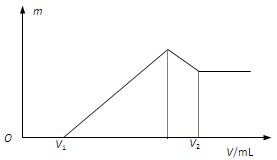问题
计算题
(9分)将0.1mol的镁铝混合物溶于100mL 2 mol·L-1的H2SO4中,然后再滴加1 mol·L-1的NaOH溶液。请回答:

(1)若在滴加NaOH溶液的过程中,沉淀质量m随加入NaOH溶液的体积V的变化如图所示。当V1=160mL时,则金属粉末中,n(Mg)=_______mol,V2=_______mL。
(2)若在滴加NaOH溶液的过程中,欲使Mg2+、Al3+刚好沉淀完全,则滴入NaOH溶液的体积V (NaOH)=_______mL。
答案
(1)0.06 440 (2)400
(1)根据图像可知硫酸是过量的,当V1=160mL时,和金属反应的硫酸是0.2mol-0.16mol÷2=0.12mol,。设混合物中镁和铝的物质的量分别是x、y,则x+y=0.1mol、x+1.5y=0.12mol,解得y=0.04mol,x=0.06mol。所以和氯化镁、氯化铝反应消耗的氢氧化钠分别是0.12mol和0.12mol,而溶解氢氧化铝消耗的氢氧化钠是0.04mol,共计0.28mol,需要氢氧化钠溶液的体积是280ml,所以V2=160ml+280ml=440ml。
(2)根据(1)可知,要生成的沉淀最多,需要氢氧化钠溶液的体积是400ml。

 ,若f(a)=2,则实数a=().
,若f(a)=2,则实数a=().